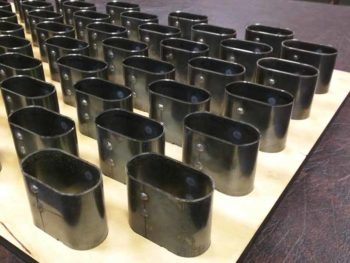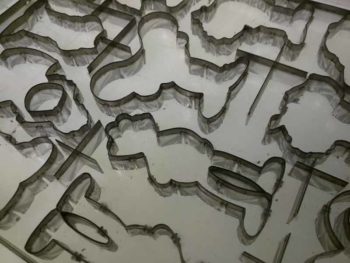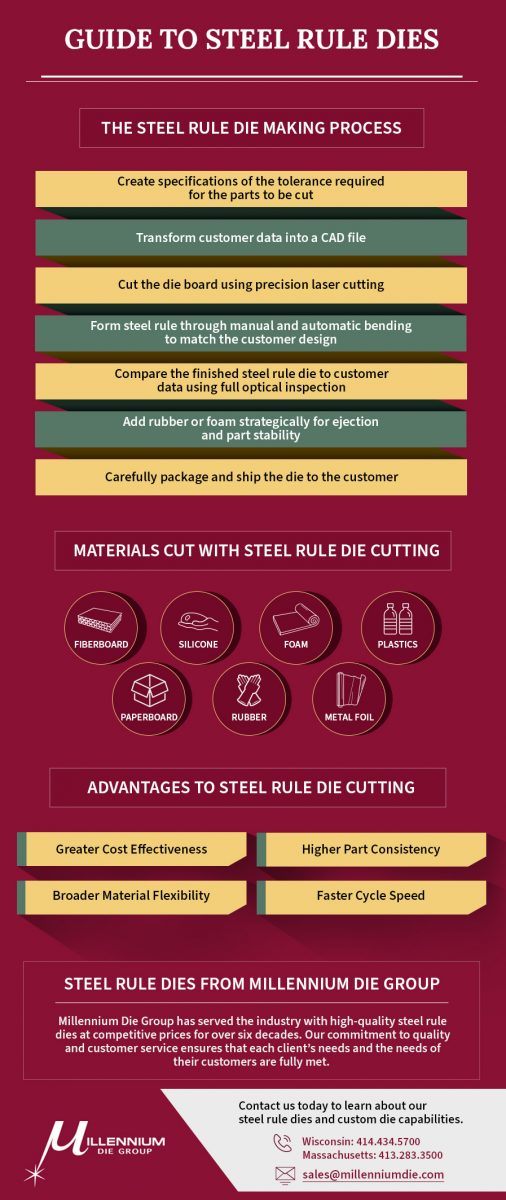All About Steel Rule Dies
Steel rule dies are cutting tools used to create many pieces of the exact same size and shape, economically, in high volume, and with a fast turnaround. Materials cut by steel rule dies are usually flat and thin, such as adhesives, films, foils, papers, rubber, foam, plastics, and thin metals. The majority of steel rule dies in the market are used to make corrugated cardboard boxes. In contrast, we make specialty steel rule dies, which are used in a variety of other applications.
In the following article, we provide an overview of steel rule dies, how they are made, including an outline of our manufacturing process, suitable materials, advantages of using them, and design and selection considerations.
What Is a Steel Rule Die?
 A steel rule die operates like a cookie cutter. It consists of three key components: the die base, the steel rule, and rubber or foam ejection.
A steel rule die operates like a cookie cutter. It consists of three key components: the die base, the steel rule, and rubber or foam ejection.
Dieboard can be made of a variety of materials, ranging from maple and birch to Lexan (aka bulletproof glass) and aluminum. The steel rule itself is a long bendable metal strip, with a sharp cutting edge that is bent into the desired design. There are several different types of rule that vary in height and thickness of the rule itself, and in the shape and type of cutting edge. A laser is used to cut a slot in the dieboard, into which the bent rule is inserted. Foam or rubber ejection is added alongside the rule. This is designed to push the cut parts clear of the tool, facilitating removal of the parts after cutting.
Once inserted in a die cutting machine, mechanical or hydraulic forces press the die blade through the stock material, cutting out a piece in the shape of the desired part. Just like an industrial cookie cutter!
Making a Steel Rule Die
The steps for manufacturing a steel rule die are as follows:
- Create specifications of the tolerance required for the parts to be cut
- Transform customer data into a CAD file
- Cut the die board using precision laser cutting
- Form steel rule through manual and automatic bending to match the customer design
- Compare the finished steel rule die to customer data using full optical inspection
- Add rubber or foam strategically for ejection and part stability
- Carefully package and ship the die to the customer
Materials Our Customers Process Using Our Dies
 When designed and manufactured correctly, specialty steel rule dies can be used to cut a wide range of materials, including the following:
When designed and manufactured correctly, specialty steel rule dies can be used to cut a wide range of materials, including the following:
- Fiberboard
- Silicone
- Foam
- Plastic
- Paperboard
- Rubber
- Metal Foil
In addition, our customers use our dies to cut the following plastics:
- Polyethylene Terephthalate (PETE)
- High-Density Polyethylene (HDPE)
- Vinyl/Polyvinyl Chloride (V/PVC)
- Low-Density Polyethylene (LDPE)
- Polypropylene (PP)
- Polystyrene (PS)
- NYLON Polyamide Plastic (PA)
- Acrylonitrile butadiene styrene (ABS)
- Polycarbonate (PC) – Lexan
- Acrylic
Our customers use parts and products they cut with our dies in a diverse set of industrial applications, including in electronic devices, enclosures, flat medical disposables, personal protective equipment for medical settings, HVAC equipment, and plumbing systems.
Advantages of Steel Rule Die Cutting
Compared to other manufacturing methods, steel rule die cutting offers several advantages, such as:
- Higher part consistency: Steel rule dies can create high volumes of parts and products with the same shape and dimensions with little to no fluctuation from one piece to the next or from batch to batch.
- Greater cost-effectiveness: The process of creating the initial die is relatively inexpensive, which is particularly useful for short to medium production runs.
- Broader material flexibility: Steel rule dies can be used to cut a broad selection of materials, ranging from soft materials like paper and rubber, to semi-rigid materials like aluminum and sheet metal.
- Faster cycle speeds: The presses used in steel rule die cutting operate at high speeds, which translates to high production efficiency.
Design and Material Selection Considerations for Steel Rule Dies
When designing a steel rule die, manufacturers need to keep in mind several factors to ensure the die meets all part and production specifications. Some of the key considerations include:
- Material. The material being cut is the primary consideration in the design and manufacture of a steel rule die. The thickness and compressibility of the material are considered in choosing the steel rule’s thickness and the cutting edge’s length and angle. These characteristics may in fact determine whether a die cutting method will be effective.
- Design. The CAD design interprets the geometry of the steel rule die to make it manufacturable. The shape or geometry of the part needs to take into consideration how producible it is, the proximity of features, and the functionality to the end user.
- Machine specifications. The die presses used in steel rule die cutting operations can be configured to suit particular part and production specifications. The part design and material are two of the primary factors that affect the ideal machine configuration.
- Production quantity. The quantity of needed parts can influence the design of the die. It is common to put a number of copies of the same part into the design of the die so that each time the die cuts, a multiple parts are cut at the same time from the same piece of material, speeding the overall production and reducing the cost.
- Production volume. In general, steel rule die cutting is appropriate for small- to medium-sized runs. With abrasive material, that might be 10,000 impressions. For soft materials under favorable conditions, that might 300,000 impressions. For longer runs, a more durable—and therefore more expensive—type of die or an alternative cutting process is required.
- Deadlines. A strict delivery date for die cut parts may affect which die provider a manufacturer chooses for their project. Steel rule dies are typically produced quickly, in 1 to 3 days. Alternate techniques, such as using a machined tool, take much longer to produce and typically cost 8 times the price of a steel rule die, or more. While suitable for long runs and providing greater accuracy, more attention to detail is required because of the number things that can go wrong and technical difficulties.
Contact the Die Experts at Millennium Die Group Today
Above, we provide an overview of steel rule dies, including how to manufacture them, what materials they are suitable for, key benefits, and design and selection considerations. For more information on these manufacturing tools, turn to the experts at Millennium Die Group.
Founded in 1953, Millennium Die Group has served the industry with high-quality specialty steel rule dies at competitive prices for over six decades. Our commitment to quality and customer service ensures that each client’s needs and the needs of their customers are fully met.
For additional information about steel rule dies or our custom die capabilities, contact us or request a quote today.

